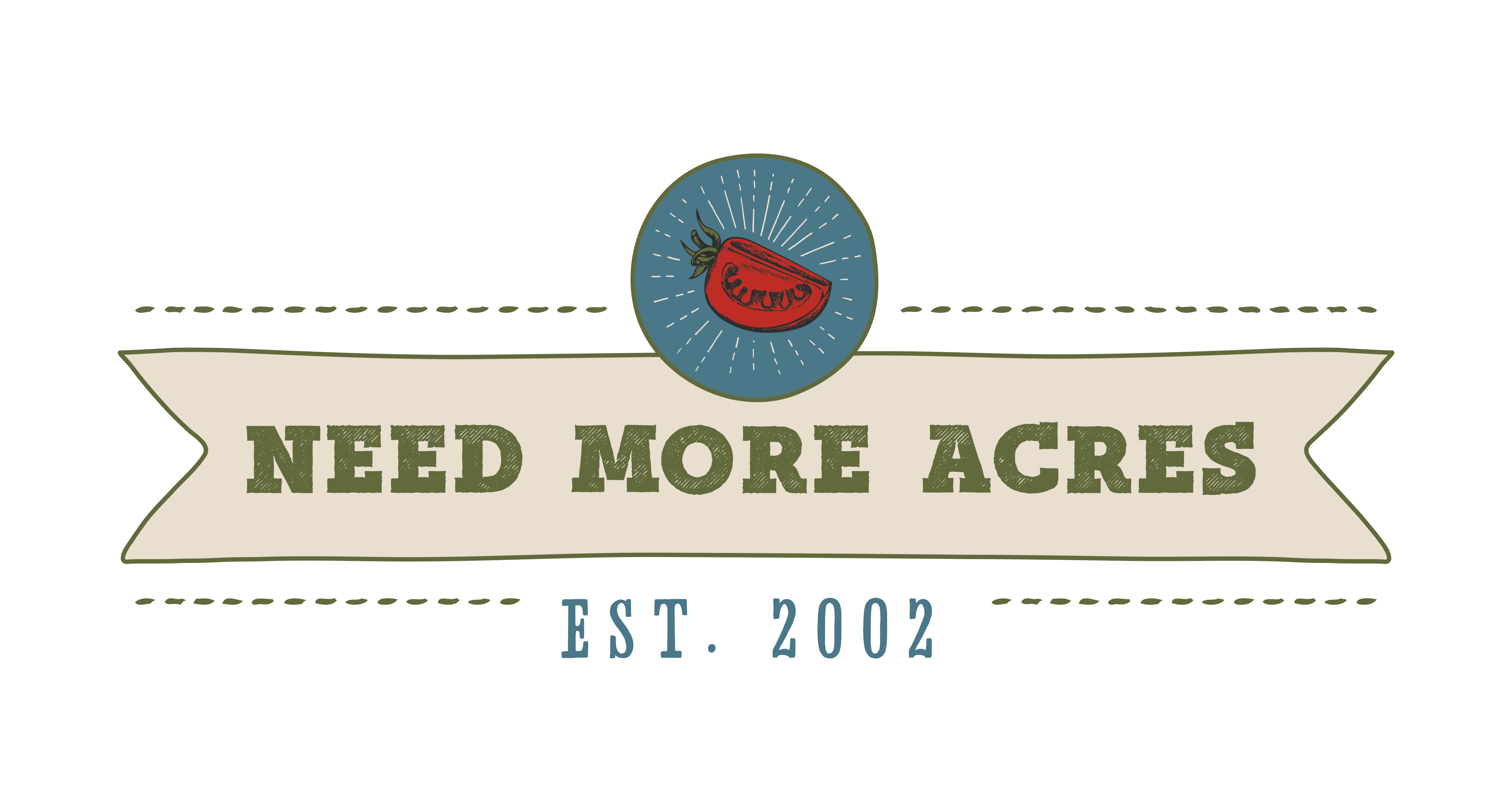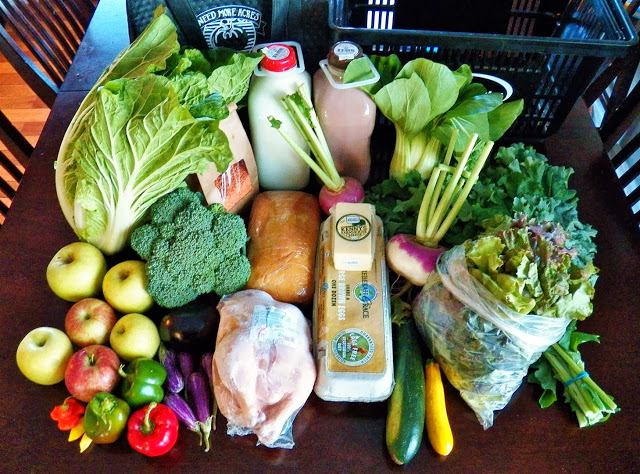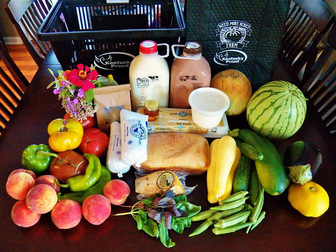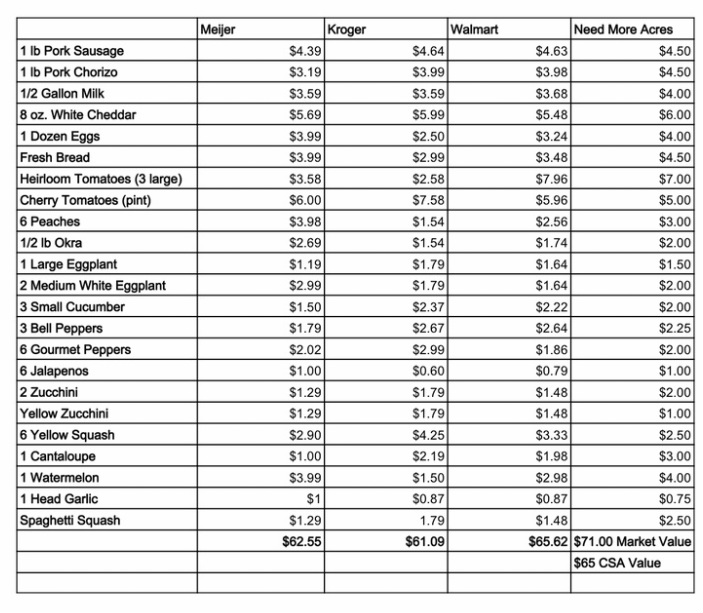Update 2-15-2015: Community Farmers Market in Bowling Green will host a CSA fair on March 21st. This will be a great opportunity to learn about all the ways you can make a commitment to local farmers and makers. More info
Let me start with a confession. Just a few years ago I was saying-or at least thinking-the same thing. Nathan and I are both very, very frugal. Let me give you an example-Nathan spent countless hours this past week taking nails out of old boards in order to reuse them for our chicken houses and I cut towels down into smaller rags so I didn’t have to buy new wash cloths. We’re cheap. Throughout the years we’ve wandered through times when we had to be frugal and other times it just felt like the right thing to do. I’ve met many rural farmers who buy the cheapest-most often processed-food available for this very reason. The first few years that Nathan sold at a local farmers market I would stop by for a few minutes and buy a couple of things. Maybe a melon or peaches, a loaf of bread or block of cheese. I could have stocked up on more, but I didn’t. Always a reason-I had already bought eggs and that 5 lb roll of ground beef on sale, I didn’t have a list with me, I wasn’t sure what to do with those vegetables. Deep down it was because I believed it would be too expensive to purchase most of our food locally. Or maybe it was the hope that I’d strike it rich thanks to unbeatable price cuts at the grocery store at my next visit. The deals always ended up being packaged, convenience foods that were taking a toll on our bodies.
A couple years later we jumped head first into buying local food. My main motivation was becoming more intentional about eating fresh, healthy foods. I’m an all in kind of gal so when I had the notion to feed my family better it occurred to me that I could invest in a bunch of contraptions, gimmicks and diet plans or I could invest in the people I knew by name at the market. It was the motivation I needed to make some hard and fast changes and it seemed like the right thing to do.
Truths I learned from eating a mostly local diet
-Limiting trips to the grocery store cuts down on the amount of sugary, processed foods I bring into the house.
-Eating whole foods fills us up faster and for longer periods of time-so we eat less.
-Eating seasonally has additional benefits such as good digestive health, variety of nutrients, increased fruit and vegetable consumption.
-The connection we’ve made to good people keeps us connected to good food.
-Time is money. I spent less time couponing and more time cooking which was in fact what really made my family healthier.
To be honest, I wasn’t completely sure that local food was cheaper or even comparable to what’s available in the grocery store, but I had a hunch that it was. Every time I go into the grocery store I cannot believe how fast the prices are rising. Transportation costs, recalls, marketing (no telling what the chain stores are spending on “local food” advertising) are all contributing to rising costs-especially on fresh food. I know more about local farm prices and I can tell you that we aren’t rising our prices quite as fast. Farmers need to make a living and we are passionate about pricing well, but farmers want to be reasonable-and for the most part they are.
In order to get a cost comparison I asked my friend Sonja to do some research for us at three of our local grocery chains. She compared the prices of each item in a weekly share from our farm. A few things to consider. Our Community Supported Agriculture program (CSA) has a $65 price point, but the value varies from week to week depending on what protein is included and what’s in season. On average, our customers receive a box that has a market value of $67-71 (the benefit of being in a CSA). This share has a slightly lower protein value, but included additional vegetables. When searching for certain products such as heirloom tomatoes and gourmet peppers Sonja had to find something comparable. I was surprised to see Walmart with the highest price and Kroger with the lowest since most people consider Kroger to be a more expensive store. What Sonja found is that local food is only slightly more expensive and when joining a CSA or getting to know your farmers (to buy in bulk) it’s about the same.
Cost Comparison based on CSA share July 2014
*please note: I’ve found that very few coupons are for fresh food (and this comes from a former coupon queen).
Tips to make local food easier
-Stock up on good extra virgin olive oil, real salt, and hard cheeses. You can do just about anything with those three things.
-Spend less time learning recipes and more time learning basic cooking skills. With a few good skills you can learn to prepare and enjoy all of the fruits and vegetables at the market.
-Ask your farmer how to prepare the food they grow. When in doubt, use google.
-Simplify: A very common meal in our home includes browned, crumbled beef or pork, vegetables cooked in olive oil and salted, sliced bread, sliced cheese and sliced cantaloupe for dessert. Simple.
-Eat what you buy. That sounds over simplified, but it is one of the biggest challenges as you transition to fresh food.
For those on a really tight budget
-Many farmers markets including our own CFM not only accept SNAP, WIC Farmers Market vouchers, Senior Nutrition vouchers, but also DOUBLE them for increased value.
-Buy at the peak of season and in bulk.
-Join a CSA for best value.
–Pick up your CSA or shop the market first, then shop for deals at the grocery. Make sure you aren’t spending the same amount at the grocery store while purchasing additional food at the market.
-Grow a garden or barter (most farmers love to barter).
Current CSA offerings at Community Farmers Market in Bowling Green, Kentucky
Farms
Sunny Point Gardens (Saturday)
Rough Draft Farmstead (Tuesday)
Think Little CSA (Tuesday)
Need More Acres CSA Farm (Saturday)
Bread
Esters Farm Baked Goods (Tuesday, Saturday)
Prepared Food
Farm Fresh But Already Fixed (Tuesday)
Zest- Juice for life. (Tuesday, Saturday)
Summer Garden Memories (Tuesday, Saturday)
Hillbilly Grillers (Saturday)
Art/Craft
Sly Dyes (Saturday)
Email Ordering/Herd Shares
Stoney Creek Farm (Saturday)
Dog Treats
Bark Twain Bakery (Saturday)




